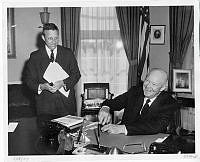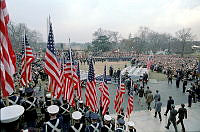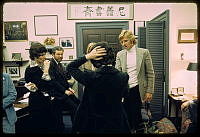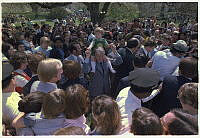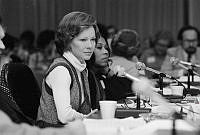Rubenstein Center Scholarship
Arlington's Ceremonial Horses and Funerals at the White House
Though presidential personalities and policies can generate deep chasms during their term of service, the death of a president evokes a genuine sadness that transcends partisan politics. Rarely are Americans as united in emotion and sensibility as at such a time. In a eulogy following President James A. Garfield’s death in 1881, Henry Watterson, journalist, editor, and later Pulitzer Prize winner, stated, “Today, the people of the United States are one with one another, and stand hand in hand and heart to heart.”1 There is an immediate synthesis of feeling surrounding news of the loss of a national leader, especially one who resided in the White House. American presidents have led their country through economic hardship, world wars, and national crises, and the simple fact that they have held the highest office in the land affords them a unique place in American hearts.
Private funerals allow mourners to stand together to remember a loved one with ritual and ceremony that allay many of the tensions associated with the loss. State funerals “lend a degree of order during the threatening, chaotic experience” of losing a president or other highranking official.2 The strict timing, ritual, and protocol inherent in state funerals reassure and comfort a grieving nation through tradition. Presidential funerals are exceptional in their pageantry, pomp, and precision, and burial with full military honors includes color-bearers, bodybearers (the official U.S. government name for pall bearers), a caisson, an escort, a band, a firing party (the official name for rifle honor corps), and a bugler. Gene Gurney, author of a book on Arlington National Cemetery, explains that “other elements of the funeral—the slow, measured pace of the cortege, the somber music and the muffled drums—exemplify the reversal of the normal order of things” and serve to underscore the nation’s loss.3
The primary responsibility for state funeral arrangements is borne by the commanding general of the Military District of Washington. However, specific decisions regarding each presidential funeral are made with family members, often well in advance of the actual death. President Gerald Ford made specific mention of this fact when eulogizing journalist and presidential historian Hugh Sidey in November 2005. In his opening remarks Ford said to mourners, “Like most men my age, I have given a thought or two to my funeral. As a former president, I’m almost required to, since the military periodically updates its own plans, and each presidential family is solicited for personal touches.”4
The Third United States Infantry, better known as the Old Guard, is the military unit charged with overseeing diplomatic arrivals and departures and maintaining the perpetual guard at the Tomb of the Unknowns; however, it may be more widely recognized for performing burials in Arlington Cemetery with all the ceremonial accoutrements and for providing the caisson platoon and pall bearers for state funerals. Members of the Old Guard also serve as escort to the president for ceremonial purposes. As the Old Guard is the oldest active infantry regiment in the United States Army, it is fitting that this unit should bear the responsibility for the supervision, direction, and performance of ceremonial functions and funerals; however, it is also appropriately tasked with safeguarding the nation’s capital through the coordination and maintenance of situational awareness, the employment of forces for homeland defense, and military assistance to civil authorities.
Following the Revolutionary War, the Old Guard was created on June 3, 1784, after the victorious Continental Army had been disbanded. According to the provisions of the 1783 Peace of Paris, Congress was required to create an army. Only a small artillery detachment, posted to West Point, had been retained, and this became the Old Guard.5 Although the Third Infantry Regiment has been stationed at numerous military facilities since its inception, its home has been at Fort Myer, Virginia, just across the Potomac from the nation’s capital since 1948.
For some, it is perhaps a stark reality that the famous Third Infantry Regiment, most especially the Caisson Platoon, spends five days a week practicing and performing burials (averaging six per day) at ArlingtonNational Cemetery. In 2005, the Caisson Platoon participated in 1,780 funerals. These troops are selected for their soldierly appearance and superior discipline; similarly, the horses for the unit are chosen for their color, height, and temperament. The solemn dignity that the men and horses lend to each funeral service is “not simply accidental or instinctive,” explains the regiment’s public information office. “Both men and horses train constantly for this duty. Most of the soldiers come to Fort Myer not as expert horsemen, but as trained infantrymen. Many come from rural areas of the South and West and bring with them a knowledge and love of animals. In addition to caring for the horses, he or she must learn to ride at the position of somber attention with a military forward seat in a flat saddle.”6
The saddle used by the Caisson Platoon dates from the Civil War and was designed by then Army Captain George B. McClellan. Although it underwent multiple alterations during the latter half of the nineteenth century, the same basic split-seat design remains. The field artillery harness design dates to the 1890s. Old manuals from the U.S. Army Quartermaster Corps, have allowed soldiers to act as farriers and also to handcraft all the saddles, bridles, and tack needed for their missions. Specifically, Eugene Burks has served as saddlemaker for the Caisson Platoon since 1981. He currently produces and maintains the tack for over forty head of horses, including a large assortment of military saddles, postillion harnesses for several teams of six horses, strap goods, bridles, halters, saddlebags, and girths.
As in the leather shop, all facets of the unit are highly specialized, and the horses and riders train, drill, and live together until they are deemed qualified to conduct the ceremonial missions. Most horses undergo extensive training to prepare them for the sights and sounds in Arlington National Cemetery. They must be able to maintain their composure around gunfire, cannon fire, vehicular traffic, bands, flags, and low-flying aircraft. Six horses pull each caisson through its specified route, and the horses are matched and sent out in either lightor dark-colored teams. The website of the Military District of Washington describes the arrangement: “Each team is grouped into three pairs: the lead pair is in front, the swing team follows and the nearest the caisson is the wheel pair. Although all six animals are saddled, only those on the left have mounted riders. This is a tradition which began in the early horse-drawn artillery days when one horse of each pair was mounted, while the other carried provisions and feed.” Horses for the Caisson Platoon come from ranch owners across the United States. Currently there are about forty-seven horses, most of which are stabled at Fort Myer; the rest are at a training facility at Fort Belvoir, Virginia.7
The use of limbers and caissons (from the French for “artillery wagon”) for the burial of military personnel appears to have originated in the beginning of the era of light mobile field artillery in the eighteenth century. When a caisson was unloaded on the battlefield, presumably it would reload with wounded, dead, or dying soldiers of the battery it had just resupplied. This matter of conveyance was later carried over and formalized into the use of a caisson for the burial of a singular fallen soldier in his coffin.
Tradition is highly valued by members of the Third Infantry Regiment. Old customs and habits are studied, practiced, and employed in the execution of their duties. The practice of having the charger of a deceased military officer led in the funeral procession, for example, is a survival of the ancient custom of sacrificing a horse at the burial of a warrior. The Mongols and Tatars in the days of Genghis Khan and Tamerlane believed that the spirit of a sacrificed horse went through the “gate of the sky” to serve its master in the afterworld. According to European folk belief, the spirit of a dead horse would find its dead master if permitted to follow him into the hereafter. Otherwise the dead master’s spirit would have to walk. Some of the Plains Indians in America also adopted the custom of sacrificing the horse at the burial of a warrior after they came into possession of horses following the Spanish discovery. In 1804, Meriwether Lewis and William Clark visited the grave of Blackbird, a great Omaha chief who had been buried sitting on his favorite horse. Although horses are no longer sacrificed, riderless horses are still led in funeral processions to symbolize the custom.8
The riderless, or caparisoned (ornamentally covered), horse is considered a symbolic representation that the deceased was mounted in this life and will continue to be mounted in the hereafter. In American state cere monies, for a caparisoned horse to be included, the person honored must have, at one time, achieved the rank of army or marine corps colonel or above. Because the president of the United States is the commander in chief of the armed forces, he is automatically entitled to theuse of the horse. Some historical records indicate that Abraham Lincoln was the first president to have been honored by the inclusion of the caparisoned horse in his funeral cortege. When his coffin was being carried to his grave in Springfield, Illinois, it was followed by his personal horse, Old Bob, with its master’s boots backward in the stirrups to signify that the deceased would never ride again. However, Tobias Lear, George Washington’s personal secretary, recorded that Washington’s horse was a part of Washington’s funeral: “The General’s horse, with his saddle, holsters, and pistols, [was] led by two grooms, Cyrus and Wilson, in black.”9 In addition, Zachary Taylor’s personal horse, Old Whitey, was in his funeral procession. The use of reversed boots in the stirrups during a funeral is comparable to the infantry’s custom of “slope arms,” a position in which the rifle is reversed so that the muzzle is pointed to the ground during burial ceremonies.
The equipment a caparisoned horse bears differs according to its color: if black, the horse carries saddle blanket, saddle, and bridle; if any other color, the horse carries a folded hood and cape, along with a blanket, saddle and bridle. All of the caparison is black. The hoodsaddle blanket, and cape are made of wool or serge—a strong, twilled fabric with diagonal rib—and all brass and leather is highly polished. Also, in the case of a presidential death, the Presidential Seal is placed on the rear corners of the blanket, four inches from the bottom.
Perhaps the most famous caparisoned horse was Black Jack, named after General John J. “Black Jack” Pershing. Black Jack was foaled January 19, 1947, and came to Fort Myer from Fort Reno, Oklahoma, on November 22, 1952. He was the last of horses issued by the U.S. Army Quartermaster Corps and the last to be branded with the army’s “US” on the left shoulder, with his army serial number, “2V56,” on the left side of his neck. Black Jack weighed 1,050 pounds and stood fifteen hands high. On Black Jack’s twenty-ninth birthday, President Richard Nixon wrote, “Black Jack has been a poignant symbol of our nation’s grief on many occasions over the years. Citizens in mourning felt dignity and purpose conveyed, a simpler yet deeper tribute to the memory of those heroic ‘riders’ who have given so much for our nation. Our people are grateful to Black Jack for helping us bear the burden of sorrow during difficult times.”10 Nixon’s penned words highlight the way inwhich the use of a caparisoned horse was becoming synonymous with laying a national hero to rest.
Although Black Jack garnered fame during the funeral of President John F. Kennedy, he also took part in the funerals of Herbert Hoover, Douglas MacArthur, Lyndon Johnson, and literally thousands of others in Arlington Cemetery during his many years of service with the Old Guard. Black Jack was retired to the Fort Myer stables on June 1, 1973, and lived for three more years in a stall decorated with red, white, and blue. Until his death on February 6, 1976, Black Jack received an average of fifty visitors a day. He also received fan mail, Christmas cards from all over the world, and “numerous requests for clippings from his tail and horseshoes.”11 Clearly, he captured many hearts. He is buried on the post parade ground at Fort Myer, Summerall Field, near the post headquarters flagpole. At the time of Black Jack’s retirement, a horse named Raven assumed his duties. Currently, the most well recognized horse in the Fort Myer stables is Sergeant York, the caparisoned horse that participated in President Ronald Reagan’s funeral in 2004.
The incorporation of specialized music, gunfire, and flags are other facets of a ceremonial state funeral. For example, “Taps” is widely recognized as the music thatconcludes a ceremonial funeral honoring the deceased’s service to country. The music and words to “Taps” were composed by General Dan Butterfield at Harrison’s Landing in July 1862, to replace the earlier “Tattoo,” or “Lights Out,” which he thought too formal. The call became known as “Taps” because it was often tapped out on a drum in the absence of a bugler. It was officially adopted by the U.S. Army in 1874 and later was used as a figurative call to the sleep of death for soldiers. Graveside military honors also include the firing of three volleys each by seven service members. This practice also recalls old battlefield customs of ceasing hostilities while both sides cleared their dead from the battlefield. Once the dead had been properly cared for, each side would fire three volleys to indicate they were ready to resume the battle.
The death of a U.S. president involves other ceremonial gun salutes and military traditions. On the day after the death of the president, former president, or president-elect (unless this day falls on a Sunday or holiday, in which case the honor will be rendered the following day), the commanders of army installations with the necessary personnel order that one gun be fired every half hour, beginning at reveille and ending at retreat. On the day of burial, these same installations fire a twenty-one gun salute starting at noon and a fifty-gun salute (one round for each state) at five second intervals immediately following the lowering of the flag.
Yet perhaps the most recognizable trapping of a military or state funeral is the flag-draped coffin. The blue of the flag is placed at the head of the coffin, over the left shoulder of the deceased. In 1918 the U.S. Army, at the suggestion of Major General George W. Cocheu, officially began the practice of placing a flag over the coffin and presenting it to the next of kin at the conclusion of the funeral service, though the custom dates to the Napoleonic Wars of the late eighteenth and early nineteenth centuries, when a flag was used to cover the deadas they were taken from the battlefield on a caisson. Today the flag-covered coffin is a symbol that a soldier’s country assumes the solemn and sacred obligation of burying its fallen.
Although not every president has received a state funeral with all of these trappings, each is entitled to the honor. Over time, presidents and their families have increasingly chosen to use one of the most poignant aspects of a state funeral ceremony—horses in the funeral cortege. Following a service for Abraham Lincoln in the East Room of the White House, the late president’s coffin was drawn to the Capitol by six horses pulling a “fourteen-foot long hearse that very much resembled a draped and decorated wagon.”12 Less than two decades had passed since President Lincoln’s death when President Garfield was also struck down by an assassin’s bullet. Although Garfield was buried in his home state of Ohio, his funeral procession from the Capitol to the train station included a horse-drawn caisson. According to eyewitness reports, the hearse “was drawn by six irongray horses, each led by a colored groom.”13 There is no evidence of a caparisoned horse being used. Similarly, upon the death of former President William Howard Taft in 1930, the Old Guard supplied the caisson and caisson detachment for the escort from the Taft residence to the Capitol and from the cemetery gate to the grave. Taft was the first of two presidents to be buried at Arlington National Cemetery. Again, there is no reference to a caparisoned horse being employed.
When President John F. Kennedy was assassinated in 1963, Mrs. Kennedy was desirous that her husband’s funeral rites be memorable and historic, and his ceremonial processions be given dramatic impact for the world to see. The first cortege bore his body on a flag-draped caisson from the White House to the Capitol on November 24, 1963. Three pairs of matched gray horses pulled the caisson. Behind the caisson, a member of the Coast Guard carried the presidential flag, and behind the flag walked Black Jack. The biographer of this horse observed, “Black Jack’s vitality was impressive. Every step of the way his head bobbed up and down as he energetically tugged on his walker’s line.”14 Black Jack was later a part of the processional that carried Kennedy’s coffin from the Capitol to a brief stop at the White House and on to the church service at Saint Matthew’s Cathedral. Following the service, the caisson and caparisoned horse took the final walk with the president’s remains to Arlington National Cemetery. Just as the Old Guard followed decades-old protocol in carrying out a funeral, Mrs. Kennedy, together with the designer of the Kennedy gravesite, architect John Carl Warnecke, worked to make the gravesite “combine the ideas and feelings of the present with the traditions of the past,”14 and the idea for the eternal flame was born.
The death of President Kennedy introduced military tradition and state ceremonies to a new generation of Americans, and Robert Hazel, novelist and poet, composed a poem entitled “Riderless Horse” that crystallized the haunting images surrounding the funeral for the late president:
Riderless Horse
From Andrews Field you ride into the Capital.
A guard of honor escorts your sudden corpse
down an aluminum ladder.
Your widow stalks your body through an avenue
of bare sycamores, and one answering bell,
leading heads of state to altar and precipice.
On the birthday of your son, your widow
walks bars of a dirge on the pavement
towards fountain and abyss.
Among swords of sunlight drawn by the spokes
of the caisson
and the white manes of horses, she walks
into noon and midnight.
Above the muffled drums,
the high voice of a young soldier
tells the white horses how slow to go
before your widow and children, walking
behind the flag-anchored coffin—
and one riderless black horse dancing!16
Although the death of President Kennedy brought the Old Guard and its military traditions into the national spotlight, the activities surrounding the funeral also brought tragedy to the members of the Third Infantry Regiment. Captain Michael D. Groves, the officer responsible for the military arrangements at the funeral of the president, died of a heart attack the next month, on December 3, 1963, at home while dining with his family, at the age of twenty seven. He was responsible for the training and supervision of the body-bearers, deathwatch, rifle firing party, and caisson escort for the services at the White House, the Capitol, and Arlington Cemetery. According to a speech on the floor of the House of Representatives by Congressman James G. Fulton of Pennsylvania, “Captain Groves worked day and night to handle the arrangements . . . and overtaxed himself.”17
President Herbert Hoover’s death the following year once more triggered the Old Guard into action, and the Caisson Platoon and caparisoned horse were again deployed. Early funeral plans had indicated that President Hoover would be buried in West Branch, Iowa, and, at the time of his death, the caisson unit and horses should be transported by air to Iowa for the services. On a veterinarian’s recommendation the Old Guard had “rehearsed the logistics of the transfer by trucking the horses to Andrews Air Force Base, loading them onto a transport plane, and flying over the Chesapeake Bay for about twenty minutes” to make sure the process would be smooth and seamless when the inevitable time came.18 However, when Hoover died, his original funeral plans were changed, and a caisson unit was not required to travel to Iowa. Black Jack and a caisson team simply participated in the escort of the coffin from Union Station to the Capitol.
It is especially fitting that a caisson unit and caparisoned horse functioned in President Dwight D. Eisenhower’s funeral, because he had a direct impact on the continuation of the program at Fort Myer. During his presidency, controversy rose over the considerable cost of horse-drawn funerals when it was found that the government could save funds by substituting motorized hearses in place of the caissons. The army vice chief of staff issued an order to abolish all future horse-drawn units. President Eisenhower immediately interceded and ordered horse-drawn funerals to continue.
Upon President Ronald Reagan’s death in California in 2004, his body was transported to Washington for the state funeral. At 16th Street and Constitution Avenue, NW, on June 9, 2004, President Reagan’s coffin was transferred to an Old Guard horse-drawn caisson from a hearse for the journey to the Capitol. This was the same location in which President Lyndon Johnson’s coffin had been transferred to a caisson in 1973. Reagan had been an avid horseman, and the boots that were reversed in Sergeant York’s stirrups were the president’s own brown riding boots provided by Mrs. Reagan, who asked that they not be altered in any way. This arrangement was unusual; under most circumstances, the boots used with the caparisoned horse are ceremonial pairs maintained and stored by the Old Guard.
Members of the Old Guard have furnished their services to their commanders in chief on numerous mournful occasions, and presidents have elected to highlight their singular service in various ways. On the bicentennial of the Third Infantry Regiment in 1984, President Ronald Reagan sent a letter to the unit espousing its “unparalleled reputation for discipline, precision, and dedication”19 to each distinctive mission. President Harry Truman, on the other hand, chose to present a trophy baton to representatives of the Third Infantry Regiment in commemoration of its long and embattled service in the army as well as the years spent in the Washington area as the escort to the president at official and ceremonial functions. Named the “Presidential Baton” by members of the regiment, it was presented on April 10, 1952, by President Truman to Colonel William W. Jenna, commanding officer of the regiment. The baton was fashioned from 136-year-old white pine used in the reconstruction of the White House after the British burned the residence in 1814. It is just over 3 1/2 feet long, weighing about 1 1/2 pounds, with silver ferrules. The wood was turned by a member of the U.S. Army Band, and the silver was donated by jewelers in the Washington, D.C., area. The baton is decorated with red, white, and blue braided cords and tassels. It is marked by a gold band just below the head with twelve stars, the Presidential Seal, and the inscription, “Original White House Material / Removed in 1950.”20 Oddly enough, during the historic Truman renovation of the White House between 1948 and 1952, much of the wood, paneling, and bricks were stored in warehouses and buried on the grounds of Fort Myer, the home of the famed regiment.
With the dedication and assistance of members of the Old Guard stationed at Fort Myer, national farewells inexorably intertwine their horses and our presidents who speak to us, metaphorically, one last time through the rhythmic cadence of the horses’ hooves on the Washington pavement, slowly drawing them toward their final resting place. In a distinctive way, horses help us say our last good-byes. Whether a president is taken from his nation through old age, disease, or an assassin’s bullet, the nation sustains a sharp and biting wound. Following the assassination of President Garfield, the Reverend Henry WardBeecher said, “We are all under a cloud. . . . We are gathered together to-night as a household would be gathered where the father had been stricken down.”21 The loss of a president temporarily cloaks the nation in darkness, and Reverend Beecher aptly speaks for all Americans.














